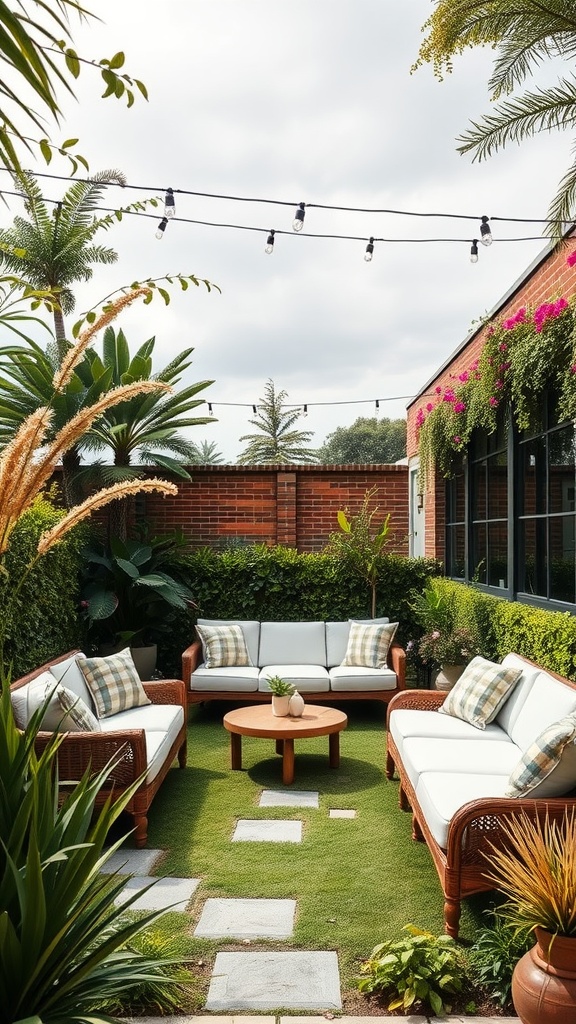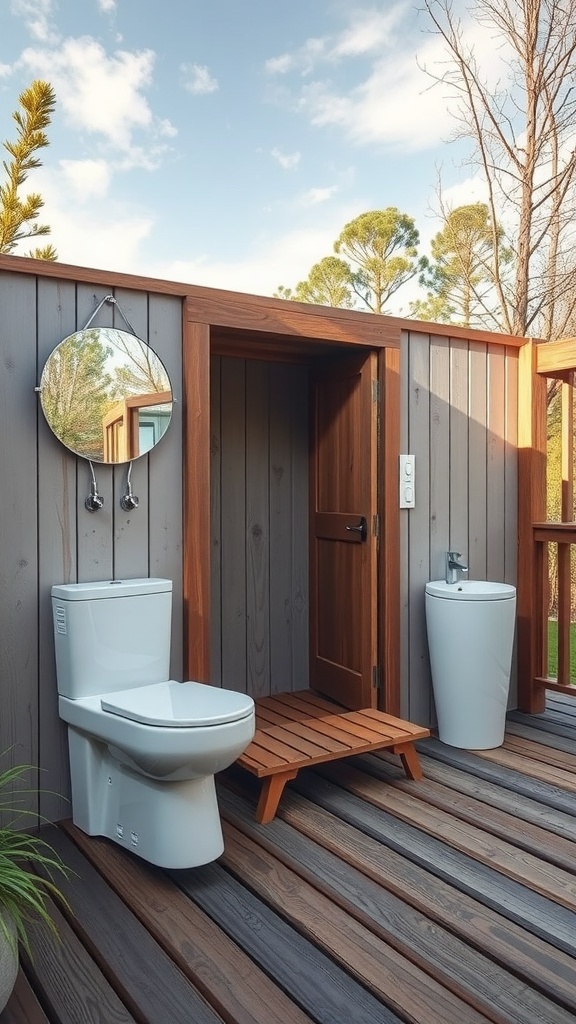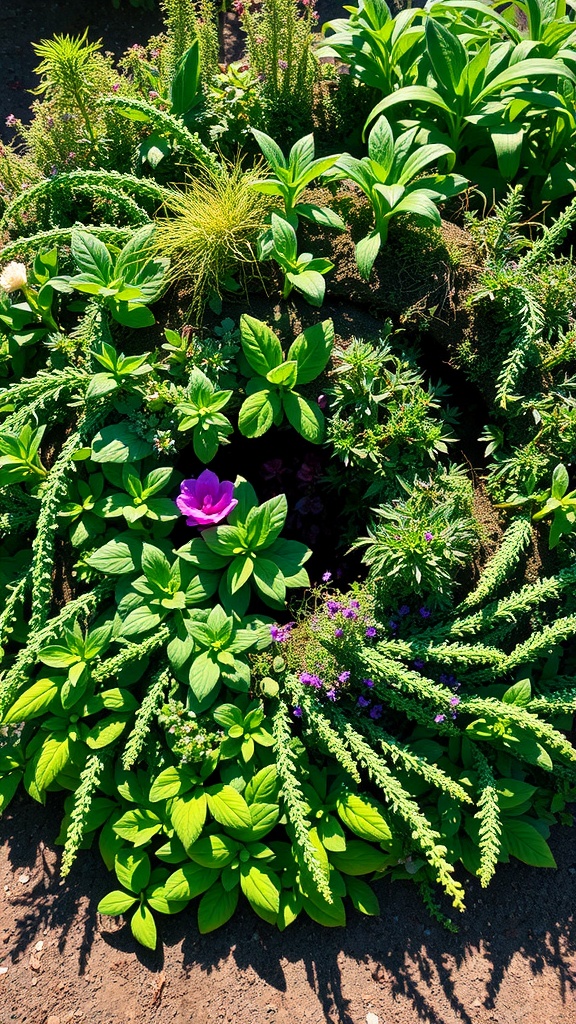When it comes to creating an outdoor living space that’s both beautiful and eco-friendly, rainscaping offers the perfect solution. Rainscaping isn’t just about managing water—it’s about blending style with sustainability, enhancing curb appeal, and nurturing a healthier backyard ecosystem.
Whether you’re refreshing your back porch decor, exploring modern back porch ideas, or investing in modern patio furniture that complements a lush garden, these rainscaping ideas will spark your imagination and help your landscape thrive—rain or shine.
Here are the first 7 inspiring rainscaping ideas to bring modern elegance and sustainable functionality to your outdoor oasis.
1. Rain Gardens
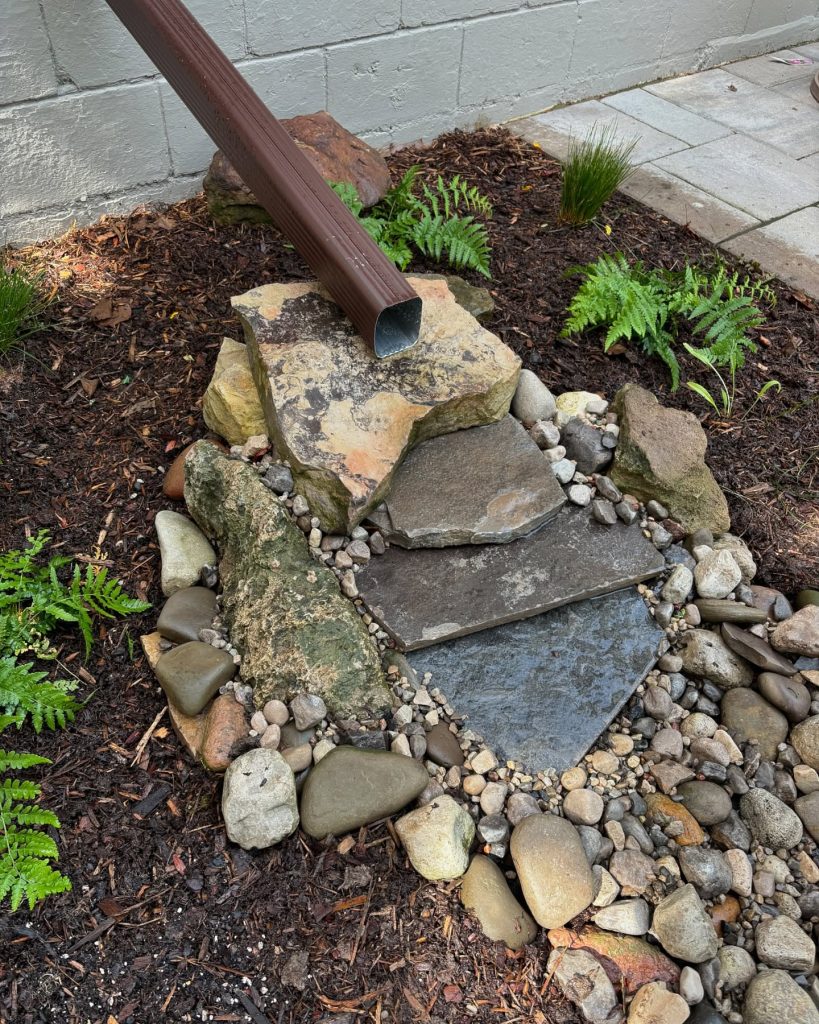
Rain gardens are a beloved staple in sustainable landscaping—and for good reason. These shallow, bowl-shaped gardens are designed to capture rainwater runoff from roofs, driveways, and patios, allowing it to soak into the ground naturally. Not only do they help reduce flooding and erosion, but they also filter pollutants, recharge groundwater, and provide a haven for pollinators and birds.
Think of a rain garden as a stylish and functional centerpiece in your backyard. You can design it with layers of colorful native plants like black-eyed Susans, swamp milkweed, coneflowers, and sedges. These plants are naturally drought-tolerant and flood-resistant, making maintenance a breeze once established.
Place your rain garden slightly downhill from your back porch or driveway where water naturally flows. Add decorative stones or gravel for a polished look and edge it with bricks or pavers for a modern aesthetic. Not only does this integrate beautifully with modern back porch ideas, but it also helps you create a sustainable, low-maintenance landscape that looks stunning year-round.
2. Permeable Pavers
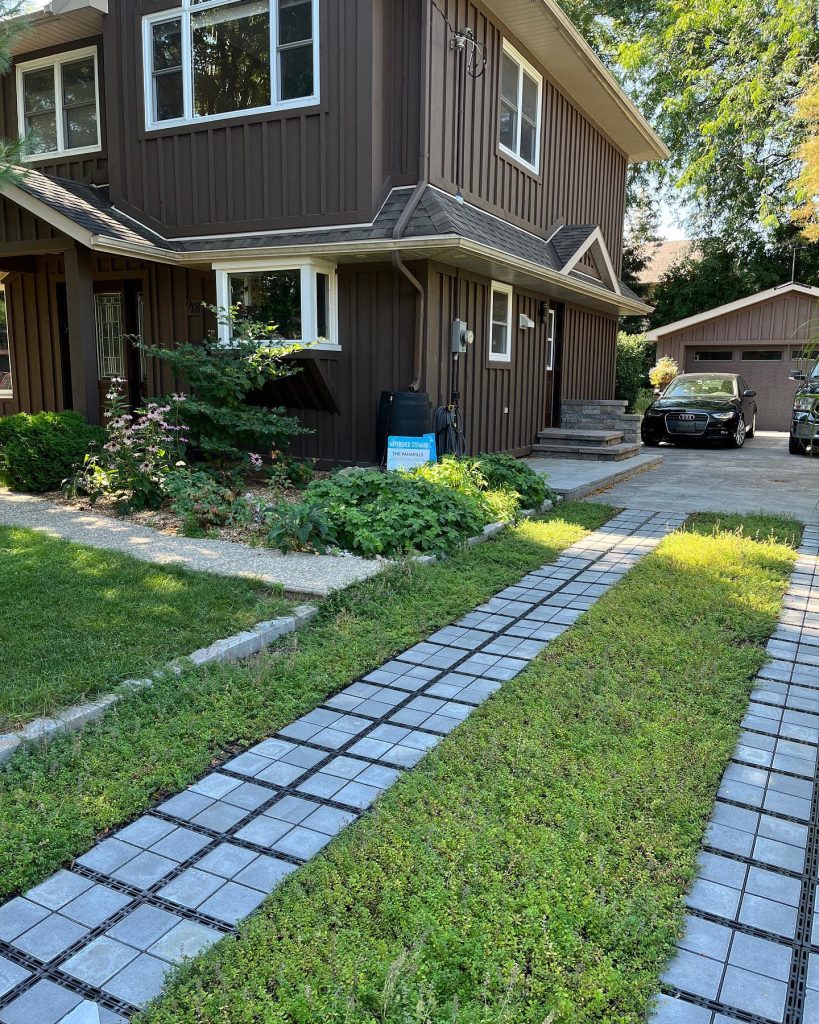
If you’re tired of water pooling on your walkway or patio, it’s time to consider permeable pavers. Unlike traditional concrete or asphalt, permeable pavers allow rainwater to pass through joints and soak into the ground below, reducing runoff and helping manage stormwater naturally.
These pavers are available in a wide range of stylish designs and materials—from eco-friendly concrete grids to natural stone or recycled rubber. They can seamlessly complement your outdoor décor and are perfect for modern patio furniture layouts. Whether you’re building a walkway, a driveway, or a chic backyard seating area, permeable pavers deliver both style and sustainability.
One of the best things about permeable pavers is their flexibility. You can incorporate them into an existing space or design an entirely new area for hosting, lounging, or dining al fresco. Add ambient lighting, a firepit, and cozy seating to make the area functional in all seasons while keeping your landscape environmentally conscious.
3. Dry Creek Beds
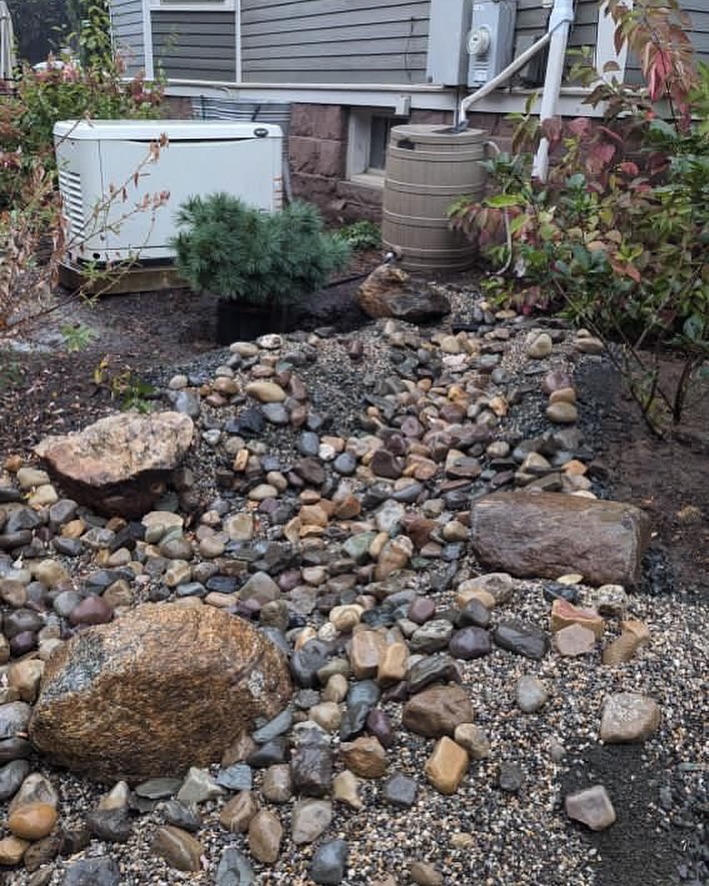
Dry creek beds offer a natural yet artistic solution to rainwater drainage issues. Designed to mimic the appearance of a seasonal stream, a dry creek bed channels excess water during heavy rainfall and adds year-round texture and beauty to your garden.
This feature blends wonderfully with both rustic and modern back porch designs. You can create a dry creek bed using smooth river rocks, decorative gravel, and native plants that can handle occasional moisture. Lining the path with ornamental grasses or flowering perennials like iris or blue flag helps enhance the visual appeal.
What’s great is that dry creek beds also double as focal points. With some creative edging and thoughtful lighting, they can become a sculptural element that brings drama and movement to your yard—even when it’s dry. It’s a fantastic addition for homeowners who want a low-maintenance, drought-resilient option that prevents erosion and keeps their property protected.
4. Rain Barrels
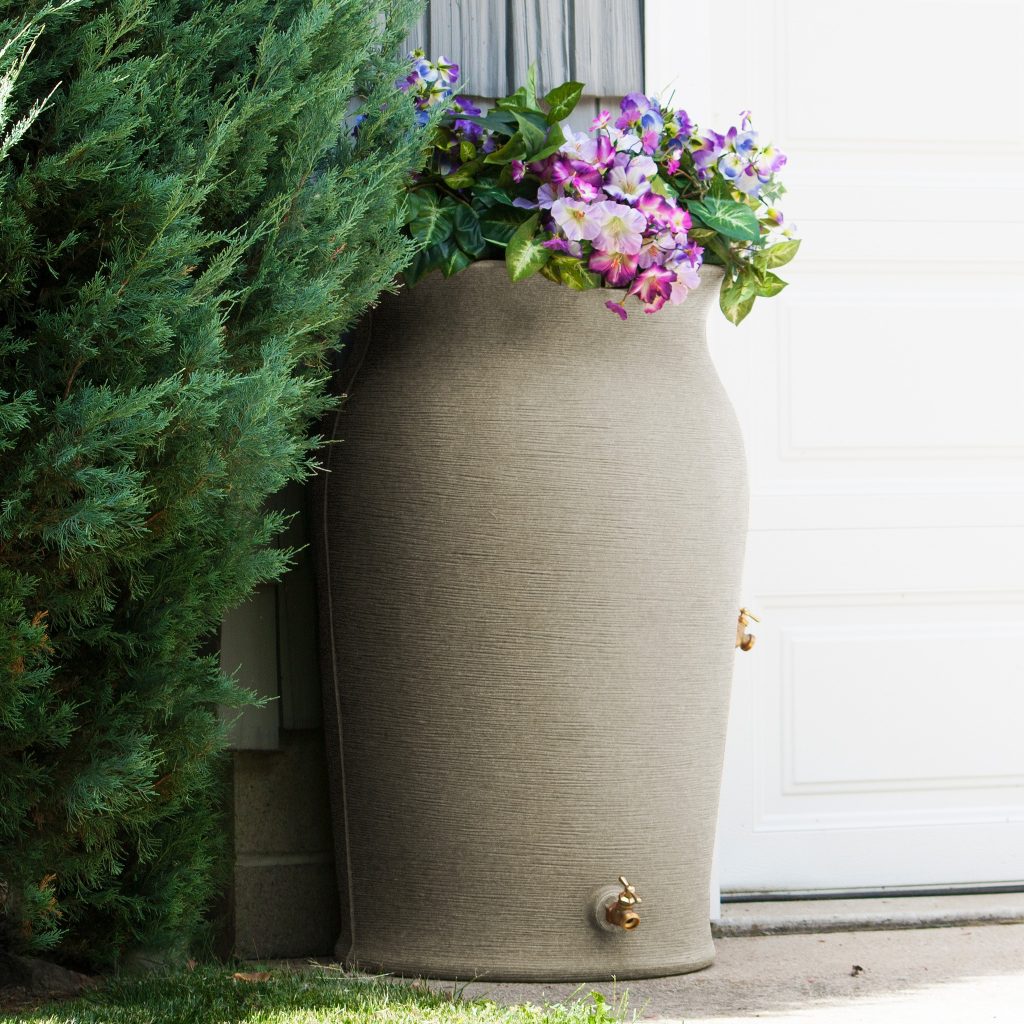
If you’re looking for a simple and affordable way to start rainscaping, rain barrels are a fantastic option. These containers collect rainwater from downspouts and gutters, allowing you to reuse it for watering your garden, lawn, or indoor plants.
Modern rain barrels come in a variety of styles, from rustic wooden barrels to sleek, UV-resistant designs that match your outdoor aesthetic. Some even include decorative elements and built-in planters on top, so they don’t just serve a purpose—they look great too.
Installing a rain barrel is usually a weekend DIY project, and it’s a great way to conserve water, especially in the warmer months when irrigation needs spike. You’ll lower your water bill and reduce the strain on stormwater systems in your community—all while giving your plants the fresh, unchlorinated rainwater they love.
Pair your rain barrel with a smart irrigation system or soaker hoses to create a low-effort, high-impact watering setup. It’s one of the easiest ways to blend function with charm in your outdoor living space.
5. Bioswales
Source
Bioswales may sound technical, but they’re a beautifully functional solution to managing heavy rainfall. These gently sloped landscape features are designed to channel and slow stormwater, allowing it to filter through layers of soil and plant roots before it reenters the groundwater supply.
Visually, a bioswale looks like a lush, meandering garden bed, often lined with rocks, native grasses, and moisture-loving plants. It can be built along driveways, property lines, or in areas where water tends to pool. The goal is to create a living filter that’s as attractive as it is effective.
What sets bioswales apart is their versatility. You can design one to reflect your personal style—whether you want a minimalist, modern look with clean edges and bold plant textures, or a wild, cottage-style garden full of color and biodiversity.
Adding a bioswale is especially helpful in urban or suburban yards where space is limited but water issues are common. It’s a way to solve drainage problems without sacrificing style or functionality, and it fits seamlessly into many modern back porch landscaping plans.
6. Living Roofs or Green Roofs
Source
Looking to turn your shed, garage, or even part of your porch roof into a lush mini-ecosystem? A living roof, also known as a green roof, is an exciting and eco-forward rainscaping idea that’s growing in popularity.
These systems are composed of layers of soil, waterproofing, and drought-resistant plants that capture and absorb rainwater, provide insulation, and reduce runoff. They not only look stunning but also extend the life of your roof and improve your home’s energy efficiency.
Living roofs can be fully or partially covered, depending on structural considerations. Popular plants include sedums, succulents, mosses, and other low-growing natives that can withstand wind, sun, and minimal water. For added flair, you can incorporate wildflowers, grasses, or even edible herbs to bring both beauty and utility.
Though installation requires planning and sometimes a structural assessment, the long-term benefits are remarkable. It’s an innovative option for homeowners who love the idea of blending architecture with nature—and who want to maximize every inch of their property in stylish, sustainable ways.
7. Rain Chains
Source
Rain chains are one of the most decorative and delightful ways to guide rainwater from your gutters to the ground. Originally a Japanese invention, rain chains offer a beautiful alternative to downspouts, turning rainfall into a visual and auditory experience.
Made from linked cups, decorative shapes, or even minimalist metal loops, rain chains guide water downward in a graceful flow. When it rains, you’ll hear the gentle trickle as the water cascades from one element to the next—like a mini waterfall on your porch.
Incorporate them into your modern back porch setup by pairing them with a stylish basin, a ceramic pot filled with river stones, or a small rain garden. Not only do they add charm and personality to your outdoor décor, but they also help prevent splash-back and erosion near your home’s foundation.
Rain chains come in a variety of finishes, including copper, stainless steel, and powder-coated colors, so you can easily find one that matches your design style. Whether you’re going for chic and contemporary or natural and earthy, rain chains elevate the look and feel of your home’s exterior with minimal effort.
8. Infiltration Trenches
Source
Infiltration trenches are one of the most under-the-radar rainscaping strategies—and they’re absolute game changers for homeowners with drainage issues. These gravel-filled ditches are installed underground to collect, hold, and slowly disperse stormwater back into the soil, rather than letting it rush off into the street or foundation.
Think of it as a hidden water management system that works silently behind the scenes. You can place an infiltration trench along the edge of a driveway, under a rain chain, or beneath areas prone to puddling. Top it off with decorative stone or a steel grate for a modern touch that blends with your patio or backyard layout.
One of the perks is that these trenches don’t require a lot of space. They’re perfect for small yards or narrow side yards where runoff tends to collect. Plus, they can be paired with other rainscaping elements—like rain gardens, rain barrels, or even turf areas—to build a more comprehensive, low-maintenance landscape that supports sustainability while preserving your outdoor style.
It’s a great solution for anyone who wants function without compromising their modern back porch decor or overall landscape design.
9. Native Plant Buffers
Source
Native plant buffers are a beautiful and natural way to intercept stormwater before it enters sensitive areas like wetlands, creeks, or your foundation. These buffers are strips or borders of hardy, native vegetation that act like sponges—slowing, absorbing, and filtering rainwater while providing habitat for birds, butterflies, and beneficial insects.
You can plant a buffer along the base of a slope, around a patio, or along your property’s edge. They work especially well in areas where lawns struggle to thrive due to water saturation. Instead of fighting with high-maintenance turf, let nature take the wheel with a border of switchgrass, bee balm, goldenrod, and wild indigo.
These plants require minimal watering and upkeep once established, and they bring vibrant color and texture to your outdoor living area. Native plant buffers fit seamlessly with modern landscaping trends that embrace biodiversity and natural beauty. Bonus: they look amazing behind modern patio furniture and along sleek stone paths.
10. French Drains
Source
French drains are a tried-and-true way to redirect excess water away from your home while maintaining a clean, polished look. Essentially, they’re underground pipes that collect water and transport it to a designated outlet—usually away from your foundation or backyard gathering space.
These systems are incredibly effective in preventing soggy lawns and waterlogged flower beds. A French drain is typically installed beneath a gravel trench and may be topped with sod or decorative stones to blend seamlessly with your landscape design.
For homes with sloped yards or areas that flood after heavy rain, this is one of the best solutions. Pair it with a rain barrel or dry creek bed for a two-pronged strategy that’s as practical as it is visually appealing.
French drains work well under decks, along the base of retaining walls, or even beneath a pergola seating area. They’re out of sight but always doing the heavy lifting, allowing you to enjoy your outdoor living space worry-free—even during stormy weather.
11. Turf Alternatives
Source
Tired of constantly mowing, watering, and fertilizing your lawn? Turf alternatives offer a beautiful, low-maintenance solution that’s both eco-conscious and stylish. From native grasses to groundcovers like clover, creeping thyme, or sedum, these options create lush, soft carpets that handle foot traffic and soak up rainwater efficiently.
Unlike traditional turf, which tends to shed water and require chemical upkeep, turf alternatives improve soil health and water infiltration. They’re also better for pollinators and easier on your schedule—not to mention your water bill.
Creeping thyme, for instance, releases a lovely fragrance when walked on and blooms in subtle shades of purple and pink, making it a lovely accent near patios or pathways. Ornamental grasses bring height and motion to your backyard design, while options like moss can create a zen-like vibe around your porch or garden seating.
They also play nicely with modern patio furniture and back porch decor, creating a relaxed yet refined feel that supports sustainability without sacrificing style.
12. Cistern Systems
Source
If you’re ready to take water harvesting to the next level, a cistern system is the way to go. Unlike rain barrels, cisterns are large-scale storage tanks designed to capture and store hundreds—or even thousands—of gallons of rainwater.
These systems are ideal for larger properties or for homeowners serious about reducing their dependence on municipal water. They can be installed above or below ground and often come equipped with pumps, filters, and overflow controls. Some even connect directly to your home irrigation or plumbing systems.
A well-designed cistern system can be hidden beneath a garden bed, deck, or custom bench seating area, blending effortlessly into your outdoor space. You’ll not only save water but also reduce runoff and protect your landscaping investment during dry spells.
Best of all, a cistern doesn’t have to look industrial. With thoughtful integration, it can be a sleek, modern feature in your outdoor living setup—especially when surrounded by clean hardscaping, greenery, or sculptural planters.
13. Green Walls or Vertical Gardens
Source
Vertical gardens—also known as green walls—offer a fresh, space-saving way to incorporate greenery while managing water. These installations consist of mounted panels or frames filled with soil and vegetation that naturally absorb rainfall and help purify the air.
Ideal for small yards, patios, or city balconies, vertical gardens bring life to blank walls and offer excellent insulation against heat and sound. They’re also effective in reducing water runoff from nearby hard surfaces by capturing and using rain directly.
Whether you go for a sleek modular system or a DIY pocket wall filled with herbs and succulents, a green wall adds instant sophistication to your space. Imagine relaxing on your back porch, sipping coffee while a lush wall of ferns, ivy, or edible greens sways beside you. It’s a statement piece that’s both functional and fabulous.
These living walls pair beautifully with modern back porch ideas and outdoor furniture sets, giving you that lush, garden-chic aesthetic that feels luxurious without being high-maintenance.
14. Gravel Gardens
Source
Gravel gardens are quickly becoming a favorite among modern gardeners—and they’re a perfect addition to your rainscaping toolkit. These gardens feature drought-tolerant plants nestled in gravel or coarse sand, which allows rainwater to drain efficiently and prevents runoff.
Not only are gravel gardens visually stunning, but they’re also incredibly easy to maintain. Plants like lavender, sedum, Russian sage, and yucca thrive in these dry, well-drained environments, making them perfect for areas that see heavy downpours followed by dry spells.
Gravel gardens also create a refined, contemporary look that complements minimalist architecture and modern patio furniture. With the right lighting and a few well-placed chairs or loungers, your gravel garden can become a calming retreat that invites relaxation.
They’re also a clever way to fill awkward corners or side yards with low-water, high-impact beauty. When combined with rain chains, dry creek beds, or a rain garden, a gravel garden becomes part of a cohesive, water-wise landscape design that’s both fashionable and functional.
Conclusion: Elevate Your Outdoor Living with Smart, Stylish Rainscaping
Transforming your yard into a stunning, sustainable oasis isn’t just about adding greenery—it’s about choosing smart, modern design elements that work with nature rather than against it. With these 13+ rainscaping ideas, you can improve water management, protect your property, and create a backyard that’s as welcoming as it is eco-friendly.
Whether you’re building a new patio, refreshing your back porch decor, or reimagining your outdoor living setup, rainscaping allows you to blend beauty, function, and environmental responsibility. From vertical gardens and bioswales to rain barrels and native plant buffers, the possibilities are as diverse as your personal style.
And the best part? You don’t have to tackle everything at once. Start small with a rain chain or rain barrel. Then slowly build up to more ambitious features like a dry creek bed or cistern system. Every step brings you closer to a backyard that’s lush, livable, and truly aligned with the rhythms of nature.
So grab a sketchpad, pull up your favorite modern patio furniture inspiration board, and start dreaming. Because when it comes to rainscaping, your outdoor paradise is just a few drops away.
